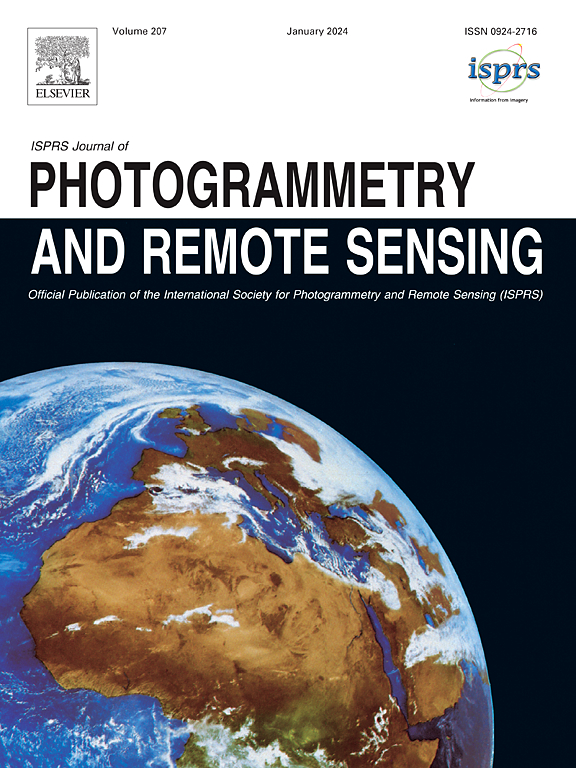OR-LIM: Observability-aware robust LiDAR-inertial-mapping under high dynamic sensor motion
IF 10.6
1区 地球科学
Q1 GEOGRAPHY, PHYSICAL
ISPRS Journal of Photogrammetry and Remote Sensing
Pub Date : 2024-10-03
DOI:10.1016/j.isprsjprs.2024.09.036
引用次数: 0
Abstract
Light Detection And Ranging (LiDAR) technology has provided an impactful way to capture 3D data. However, consistent mapping in sensing-degenerated and perceptually-limited scenes (e.g. multi-story buildings) or under high dynamic sensor motion (e.g. rotating platform) remains a significant challenge. In this paper, we present OR-LIM, a novel observability-aware LiDAR-inertial-mapping system. Essentially, it combines a robust real-time LiDAR-inertial-odometry (LIO) module with an efficient surfel-map-smoothing (SMS) module that seamlessly optimizes the sensor poses and scene geometry at the same time. To improve robustness, the planar surfels are hierarchically generated and grown from point cloud maps to provide reliable correspondences for fixed-lag optimization. Moreover, the normals of surfels are analyzed for the observability evaluation of each frame. To maintain global consistency, a factor graph is utilized integrating the information from IMU propagation, LIO as well as the SMS. The system is extensively tested on the datasets collected by a low-cost multi-beam LiDAR (MBL) mounted on a rotating platform. The experiments with various settings of sensor motion, conducted on complex multi-story buildings and large-scale outdoor scenes, demonstrate the superior performance of our system over multiple state-of-the-art methods. The improvement of point accuracy reaches 3.39–13.6 % with an average 8.71 % outdoor and correspondingly 1.89–15.88 % with 9.09 % indoor, with reference to the collected Terrestrial Laser Scanning (TLS) map.
OR-LIM:高动态传感器运动下的可观测性感知鲁棒激光雷达-惯性制图
光探测与测距(LiDAR)技术为获取三维数据提供了一种极具影响力的方法。然而,在感知衰减和感知受限的场景(如多层建筑)中或在传感器高动态运动(如旋转平台)的情况下进行一致的测绘仍然是一项重大挑战。在本文中,我们介绍了一种新型的可观测性感知激光雷达-惯性测绘系统--OR-LIM。从本质上讲,该系统将稳健的实时激光雷达-惯性测距(LIO)模块与高效的曲面贴图平滑(SMS)模块相结合,可同时无缝优化传感器姿势和场景几何。为了提高鲁棒性,平面曲面是由点云图分层生成和生长的,从而为固定滞后优化提供可靠的对应关系。此外,还对曲面的法线进行分析,以评估每个帧的可观测性。为保持全局一致性,利用因子图整合了 IMU 传播、LIO 和 SMS 的信息。该系统在安装在旋转平台上的低成本多波束激光雷达(MBL)收集的数据集上进行了广泛测试。在复杂的多层建筑和大规模室外场景中进行的各种传感器运动设置实验表明,我们的系统性能优于多种最先进的方法。参照收集到的地面激光扫描(TLS)地图,点精度提高了 3.39-13.6%,室外平均提高 8.71%,室内相应提高 1.89-15.88%,室内平均提高 9.09%。
本文章由计算机程序翻译,如有差异,请以英文原文为准。
求助全文
约1分钟内获得全文
求助全文
来源期刊

ISPRS Journal of Photogrammetry and Remote Sensing
工程技术-成像科学与照相技术
CiteScore
21.00
自引率
6.30%
发文量
273
审稿时长
40 days
期刊介绍:
The ISPRS Journal of Photogrammetry and Remote Sensing (P&RS) serves as the official journal of the International Society for Photogrammetry and Remote Sensing (ISPRS). It acts as a platform for scientists and professionals worldwide who are involved in various disciplines that utilize photogrammetry, remote sensing, spatial information systems, computer vision, and related fields. The journal aims to facilitate communication and dissemination of advancements in these disciplines, while also acting as a comprehensive source of reference and archive.
P&RS endeavors to publish high-quality, peer-reviewed research papers that are preferably original and have not been published before. These papers can cover scientific/research, technological development, or application/practical aspects. Additionally, the journal welcomes papers that are based on presentations from ISPRS meetings, as long as they are considered significant contributions to the aforementioned fields.
In particular, P&RS encourages the submission of papers that are of broad scientific interest, showcase innovative applications (especially in emerging fields), have an interdisciplinary focus, discuss topics that have received limited attention in P&RS or related journals, or explore new directions in scientific or professional realms. It is preferred that theoretical papers include practical applications, while papers focusing on systems and applications should include a theoretical background.
 求助内容:
求助内容: 应助结果提醒方式:
应助结果提醒方式:


